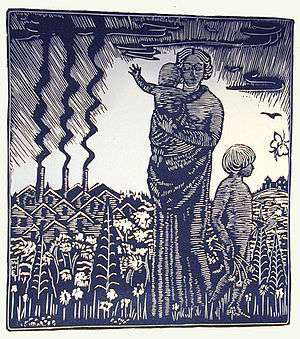Wharton Esherick
%2C_1962%2C_Metropolitan_Museum_of_Art.jpg)

Wharton Esherick (July 15, 1887 – May 6, 1970) was a sculptor who worked primarily in wood, especially applying the principles of sculpture to common utilitarian objects. Consequently, he is best known for his sculptural furniture and furnishings. Esherick was recognized in his lifetime by his peers as the “dean of American craftsmen”[1] for his leadership in developing non-traditional designs, and encouraging and inspiring artists/craftspeople by example. Esherick’s influence continues to be seen in the work of current artisans, particularly in the Studio Craft Movement.[2]
Born in Philadelphia, Esherick studied painting at the Philadelphia Museum School of Industrial Arts (now the University of the Arts (Philadelphia)) and at the Pennsylvania Academy of the Fine Arts.[3] In 1913 he moved to a farmhouse near Paoli, Pennsylvania to pursue his painting career. He began carving decorative frames for his paintings in 1920, which led to making woodcut prints and finally to sculpture.
Esherick’s early furniture was derived from the Arts and Crafts style, and decorated with surface carving. In the late 1920s, he abandoned carving on his furniture, focusing instead on the pure form of the pieces as sculpture. In the 1930s, he was producing sculpture and furniture influenced by the organicism of Rudolf Steiner, as well as by German Expressionism and Cubism. The angular and prismatic forms of the latter two movements gave way to the free-form curvilinear shapes for which he is best known.
From furniture and furnishings, he progressed to interiors, the most famous being the Curtis Bok House[4] (1935–37). Though the house was demolished, Esherick’s work was saved. The fireplace and adjacent music room doors can be seen in the Philadelphia Museum of Art and the foyer stairs can be seen in the Wolfsonian Museum in Miami, Florida.
In 1940, George Howe (architect) used Esherick’s Spiral Stair (1930) and Esherick furniture to create the “Pennsylvania Hill House” exhibit in the New York World’s Fair “America at Home” Pavilion. Esherick’s work was also featured in a 1958 retrospective at the Museum of Contemporary Craft and in the 1972 “Woodenworks” exhibition at the Renwick Gallery. He exhibited hundreds of times during his life and his work is now in the collections of the Philadelphia Museum of Art, the Metropolitan Museum in New York, the Whitney Museum in New York, the Pennsylvania Academy of the Fine Arts and many other museums. Most of his work remains in private hands.
His home and studio, outside of Valley Forge, Pennsylvania, were his largest piece of art. The buildings evolved over forty years as Esherick lived and worked there. He continued working on the studio until his death in 1970. In 1972 the studio was converted into the Wharton Esherick Museum.[3] The property, known as Wharton Esherick Studio, was declared a National Historic Landmark in 1993.
Esherick was the father of Ruth Bascom (wife of architect Mansfield Bascom,[3] curator emeritus of the Wharton Esherick Museum) and uncle of American architect Joseph Esherick.
See also
- Esherick House, with a kitchen designed by Wharton Esherick
References
- Bascom, Mansfield, Wharton Esherick: The Journey of a Creative Mind, New York, Abrams, 2010, ISBN 978-0-8109-9575-8.
- Clark, Emily, Stuffed Peacocks, by Emily Clark; Woodcuts by Wharton Esherick, New York, London, A. A. Knopf, 1927.
- Eisenhauer, Paul, ed., Wharton Esherick's Illuminated and Illustrated Song of the Broad-Axe By Walt Whitman, Atglen, Pennsylvania, Schiffer Publishing LTD., 2011.
- Eisenhauer, Paul, and Lynne Farrington, eds., Wharton Esherick and the Birth of the American Modern, Atglen, Pennsylvania, Schiffer Publishing LTD., 2010.
- Esherick, Wharton and Gene Rochberg, Drawings by Wharton Esherick, New York, Van Nostrand Reinhold, 1978.
- Renwick Gallery, Woodenworks; Furniture Objects by Five Contemporary Craftsmen: George Nakashima, Sam Maloof, Wharton Esherick, Arthur Espenet Carpenter, Wendell Castle, St. Paul, Minnesota Museum of Art, 1972
- Silverman, Sharon Hernes, "A Passion for Wood", Pennsylvania Heritage, Vol. XXIII, no. 4, 1997
- Wharton Esherick Museum, The Wharton Esherick Museum, Studio and Collection, Paoli, Pennsylvania, Wharton Esherick Museum, 1977.
- Wharton Esherick Museum, The Wharton Esherick Museum, Studio and Collection, 3rd edition, Atglen, Pennsylvania, Schiffer Publishing LTD., 2010.
Notes
- ↑ "Wharton Esherick". Modern Gallery. Retrieved 28 Dec 2011.
- ↑ "Music Stand Wharton Esherick (American, 1887–1970)". Metropolitan Museum. Retrieved 28 Dec 2011.
- 1 2 3 "Oral history interview with Mansfield Bascom and Ruth Esherick Bascom about Wharton Esherick, 1990 July 13". Oral history interviews. Archives of American Art. 2011. Retrieved 16 Jun 2011.
- ↑ "Oral history interview with Ruth Esherick and Mansfield Bascom on Wharton Esherick, 1991 Mar. 26". Oral history interviews. Archives of American Art. 2011. Retrieved 29 Jun 2011.